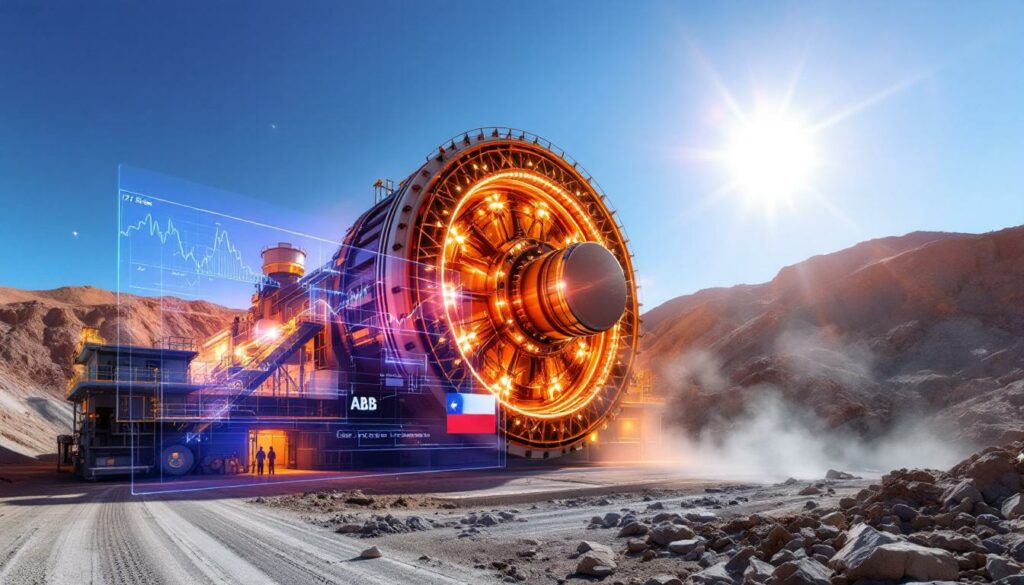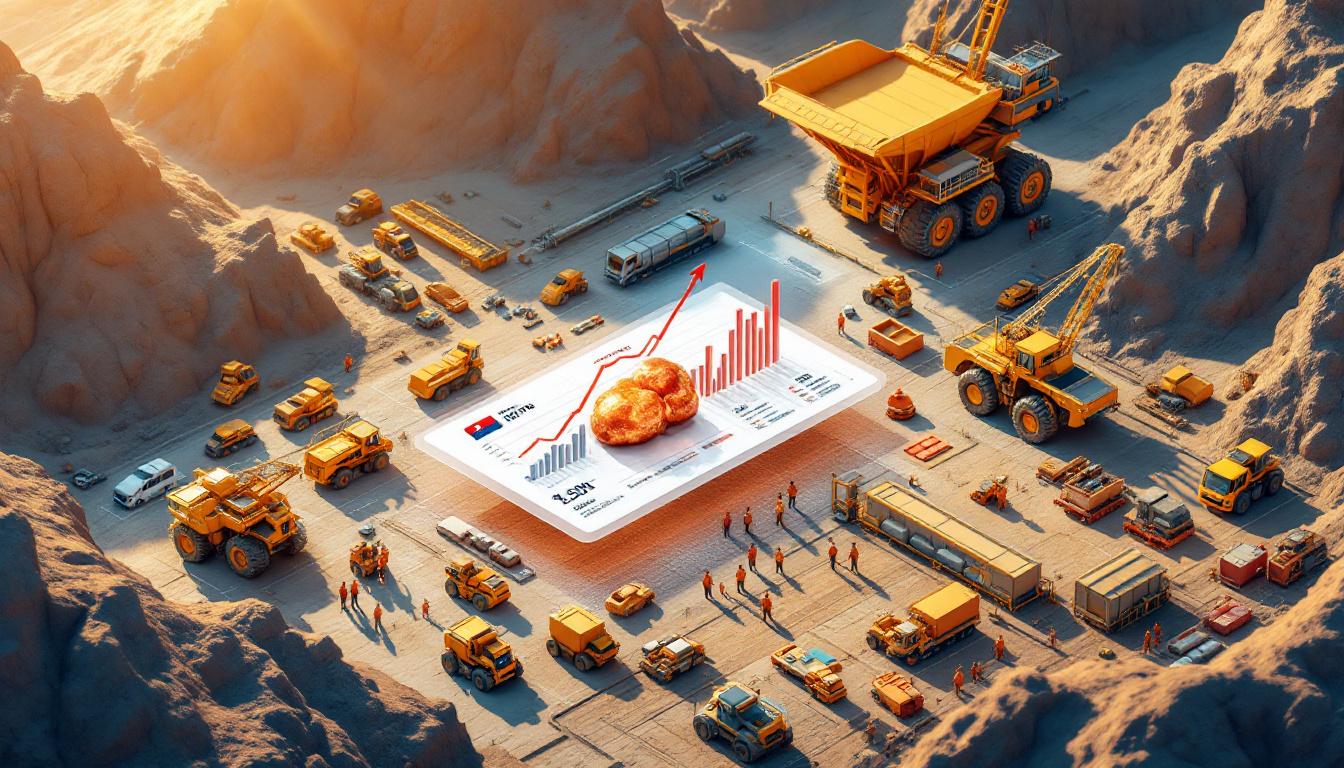Revolutionizing Mining Efficiency: How Gearless Mill Drive Systems Transform Copper Production
The mining industry is experiencing a technological revolution with the integration of advanced grinding technologies. At the forefront of this transformation are Gearless Mill Drive (GMD) systems, which are redefining operational efficiency and sustainability in copper mining operations. The recent collaboration between Antofagasta Minerals and ABB at Chile's Centinela mine showcases how these innovations are changing the landscape of mineral processing and helping establish data-driven mining operations across the industry.
Understanding GMD Technology in Modern Mining
Gearless Mill Drive systems represent a significant advancement in grinding technology for the mining industry. Unlike conventional drives that rely on complex mechanical power transmission components, GMDs directly connect the motor to the mill, eliminating gears, pinions, and other intermediate mechanical elements.
These systems feature massive ring motors that attach directly to the mill shell, providing precise control and exceptional torque. The direct-drive design significantly reduces mechanical losses and wear points, contributing to higher reliability and efficiency in grinding operations.
"Antofagasta Minerals' decision to adopt our GMD technology marks a significant milestone for ABB in the South American mining sector," notes Wilson Monteiro, Global Business Line Manager for GMD at ABB Process Industries.
The evolution of GMD technology has been driven by the mining industry's need for higher throughput, improved energy efficiency, and better adaptability to varying ore characteristics. As mines process lower-grade ores and face increasing operational costs, GMD systems have emerged as a critical solution for maintaining profitability while advancing sustainability goals through mining industry innovation.
The Critical Role of GMDs in Copper Concentrator Operations
In copper mining, the grinding circuit represents one of the most energy-intensive and critical stages of mineral processing. GMD systems play a pivotal role in this process by providing precise control over mill rotation speed, which directly affects grinding efficiency and mineral liberation.
Ball mills equipped with GMD technology can adjust their operational parameters in real-time, optimizing the grinding process based on ore hardness, density, and composition variations. This adaptability is particularly valuable in copper processing, where ore characteristics can change significantly throughout a deposit.
The integration of GMDs in concentrator operations enables mining companies to maximize copper recovery while minimizing energy consumption—a dual benefit that directly impacts both operational costs and environmental footprint. These technological improvements are critical as global copper production forecast data indicates growing demand in coming years.
How Are Antofagasta and ABB Collaborating at the Centinela Mine?
The Nueva Centinela Expansion Project Overview
The Nueva Centinela expansion represents a transformative investment for Antofagasta Minerals, positioning the operation for long-term productivity in Chile's copper sector. According to the Global Mining Review, this ambitious project will increase copper production by an impressive 144,000 tonnes per year while extending the mine's operational life by at least 30 years.
This strategic expansion comes at a critical time when global copper demand continues to rise, driven by renewable energy technologies and electrification trends. By implementing advanced grinding technology, Antofagasta is not only increasing production capacity but also enhancing resource utilization from existing deposits.
The project demonstrates how technological innovation can transform the economics of mining operations, allowing companies to process lower-grade ore bodies profitably while extending mine life—a crucial consideration for sustainable resource development.
ABB's Custom GMD Implementation
The heart of the Nueva Centinela expansion is ABB's custom-designed Gearless Mill Drive system, featuring impressive 27-ft diameter ring motors with 19.6 MW of power. These massive components represent some of the most powerful grinding technology deployed in South American mining operations.
The manufacturing process for these specialized components began in Bilbao, Spain, where the stators underwent rigorous Factory Acceptance Tests (FAT) before shipment. Following successful testing, these critical components made their journey to Puerto Angamos in Mejillones, Chile, before final transportation to the Centinela mine site.
ABB engineers designed these systems specifically for the harsh desert conditions of northern Chile, incorporating specialized features to ensure reliability in extreme temperatures, high altitudes, and dusty environments. The systems include three cycloconverter transformers that work in concert with the ring motors to optimize performance under these demanding conditions.
What Technical Innovations Make These GMD Systems Superior?
Variable Speed Capabilities for Process Optimization
One of the most significant advantages of ABB's GMD systems is their variable speed capability, which allows plant operators to respond dynamically to changes in ore composition. This adaptability is crucial in copper processing, where ore hardness and mineral distribution can vary significantly even within the same deposit.
"Variable speed capability allows plant operators to respond more quickly to changes in ore composition," notes the Global Mining Review report. This functionality enables real-time adjustments to grinding parameters, optimizing mineral liberation while preventing over-grinding—a common cause of energy waste in traditional fixed-speed systems.
By maintaining optimal grinding conditions regardless of feed variations, these systems can:
- Increase throughput when processing softer ores
- Maintain liberation quality when encountering harder zones
- Adjust to different mineral assemblages that require specific grinding conditions
- Optimize energy consumption based on actual processing requirements
This adaptive processing capability translates directly to improved recovery rates and reduced operating costs over the life of the mine.
Advanced Monitoring and Predictive Maintenance Features
The ABB GMD systems installed at Centinela incorporate sophisticated monitoring technologies that provide real-time operational data, enabling predictive maintenance and preventing costly unplanned failures.
Remote monitoring capabilities allow technical specialists to analyze performance metrics continuously, identifying potential issues before they develop into critical failures. This proactive approach to maintenance is particularly valuable in remote mining operations, where specialized technical support may not be immediately available on-site.
The system's monitoring features track:
- Motor temperature and vibration levels
- Power consumption patterns
- Bearing performance metrics
- Electrical system health indicators
- Mechanical stress indicators
These advanced diagnostics significantly reduce the risk of catastrophic failures while optimizing maintenance schedules—extending equipment life and maximizing operational availability.
What Economic Benefits Do GMD Systems Deliver to Mining Operations?
Operational Cost Reduction Analysis
The economic impact of GMD systems extends beyond their initial capital investment, delivering substantial operational savings throughout the mine's life. Perhaps most significantly, these systems dramatically reduce the risk of unplanned downtime—a critical consideration when "every hour of downtime can cost mining companies hundreds of thousands of dollars," according to the Global Mining Review.
By eliminating mechanical components like gears, pinions, and couplings, GMD systems reduce maintenance requirements and associated labor costs. The direct-drive design also eliminates power losses that occur in mechanical transmission systems, improving overall energy efficiency by 3-5% compared to conventional drives.
The maintenance advantages translate to significant cost savings:
- Reduced spare parts inventory requirements
- Lower labor costs for maintenance activities
- Extended intervals between major maintenance events
- Decreased secondary damage from mechanical failures
- Minimized production losses from unexpected downtime
These operational savings compound over time, often justifying the higher initial capital expenditure for GMD technology.
Production Optimization and Revenue Enhancement
Beyond cost reduction, GMD systems directly enhance revenue potential through improved grinding performance and process stability. The variable speed capabilities enable operators to maintain optimal grinding conditions regardless of ore variability, resulting in more consistent mineral liberation and recovery rates.
This operational consistency leads to:
- Higher overall metal recovery percentages
- More consistent concentrate quality meeting smelter specifications
- Reduced penalties for impurities in the final concentrate
- Ability to process complex or variable ores profitably
- Increased throughput capacity when conditions permit
At Centinela, these benefits will contribute directly to the projected 144,000 tonne annual increase in copper production—a significant revenue enhancement that strengthens the operation's competitive position in the global copper market.
How Do GMD Systems Support Sustainability Goals in Mining?
Energy Efficiency and Environmental Impact
Mining operations face increasing pressure to reduce their environmental footprint, and energy consumption represents one of their most significant impact areas. GMD systems address this challenge directly by improving energy efficiency throughout the grinding process and supporting broader mining decarbonisation benefits.
The direct-drive design eliminates mechanical losses present in conventional systems, while variable speed capabilities ensure the mill operates at optimal efficiency regardless of ore characteristics. According to industry benchmarks, these improvements can reduce energy consumption by 3-5% compared to geared drives—a significant saving when considering that grinding circuits typically account for 40-60% of a concentrator's total energy usage.
For a large operation like Centinela, these efficiency gains translate to:
- Reduced carbon emissions from power generation
- Lower overall environmental impact per tonne of copper produced
- Progress toward corporate sustainability targets
- Improved standing with environmentally conscious investors and stakeholders
- Potential qualification for green energy incentives or carbon reduction credits
As stated in the Global Mining Review, GMD systems contribute directly to "reducing energy consumption and emissions" while maintaining or improving production capacity.
Resource Optimization Through Precision Processing
Beyond energy considerations, GMD systems enable more precise control over the grinding process, which leads to more efficient resource utilization throughout the concentrator. The ability to maintain optimal grinding conditions results in better mineral liberation and recovery—effectively extracting more copper from the same ore volume.
This precision processing approach yields several sustainability benefits:
- More complete resource utilization from existing deposits
- Extended mine life through improved processing of lower-grade materials
- Reduced waste material per tonne of metal produced
- More consistent tailings characteristics for safer storage
- Potential reduction in water and reagent consumption through process optimization
By maximizing resource efficiency, GMD technology aligns with the mining industry's growing focus on sustainable operations and responsible resource development, which increasingly involves renewable energy in mining applications.
What Does the Future Hold for GMD Technology in Mining?
Emerging Trends in Mill Drive Systems
The evolution of GMD technology continues to accelerate, with several emerging trends pointing toward even greater capabilities in future systems. Integration with artificial intelligence and machine learning represents one of the most promising development areas, enabling predictive analytics that can further optimize grinding performance based on historical data and real-time conditions.
Other emerging developments include:
- Advanced power electronics for improved energy efficiency
- Enhanced cooling systems for operation in extreme environments
- Integration with renewable energy sources for reduced carbon footprint
- More sophisticated digital twins for virtual commissioning and operator training
- Smaller footprint designs for space-constrained installations
These innovations will likely expand the application range of GMD technology, making it viable for smaller operations while enhancing benefits for large-scale mines like Centinela.
Expansion Potential Across Global Mining Operations
The successful implementation of GMD technology at operations like Centinela's expansion project demonstrates the value proposition for other mining companies facing similar challenges. As ore grades decline globally and energy costs continue to rise, the efficiency advantages of GMD systems become increasingly compelling.
While South America has been a leader in GMD adoption for copper processing, other mining regions are increasingly recognizing the benefits. Australia, North America, and Central Asia are seeing growing implementation of this technology, particularly for large greenfield projects and major brownfield expansions.
The competitive landscape continues to evolve, with ABB maintaining a strong position alongside other providers developing similar technologies. This competition drives continuous improvement in GMD capabilities while potentially reducing implementation costs over time.
FAQ About Gearless Mill Drive Systems in Mining
What makes gearless mill drives different from conventional drives?
The fundamental difference lies in the direct connection between the motor and the mill. Conventional drives utilize a motor connected to the mill through a series of mechanical components—typically including gearboxes, pinions, and couplings—which transfer power but introduce friction losses and wear points.
GMD systems eliminate these intermediate components by integrating a large ring motor directly onto the mill shell. This ring motor consists of poles mounted around the mill's circumference, with the stator positioned around this rotor. This design eliminates mechanical losses, reduces maintenance requirements, and provides superior control over mill operation.
The direct-drive approach offers several key advantages:
- Higher overall efficiency due to eliminated mechanical losses
- Greater reliability from fewer moving parts
- Improved control precision for optimal grinding conditions
- Higher available torque for starting under load
- Lower maintenance requirements and associated costs
These characteristics make GMDs particularly valuable for high-throughput operations where reliability and efficiency directly impact profitability.
How do GMDs specifically improve grinding efficiency?
GMD systems improve grinding efficiency through several mechanisms that conventional systems cannot match:
-
Precise speed control: The direct-drive design allows for extremely precise control of mill rotation speed, which can be adjusted in real-time to match changing ore characteristics. This ensures optimal impact and attrition conditions inside the mill.
-
Variable speed operation: Unlike fixed-speed conventional drives, GMDs can operate efficiently across a wide speed range, allowing operators to find the optimal speed for different ore types and grinding stages.
-
Higher availability: With fewer mechanical components that can fail, GMD systems offer higher operational availability, maximizing productive grinding time.
-
Optimized power consumption: Direct drives eliminate the power losses associated with mechanical transmission components, reducing the energy required per tonne processed.
-
Smooth start capability: GMDs can start mills smoothly even when fully loaded, eliminating the need to empty mills before restart after maintenance or power interruptions.
These efficiency improvements directly translate to lower processing costs per tonne and higher overall metal recovery.
What maintenance advantages do GMD systems offer?
The maintenance benefits of GMD systems stem primarily from their simplified mechanical design. By eliminating gears, pinions, and other wearing components, these systems remove numerous potential failure points and maintenance requirements.
Key maintenance advantages include:
- No gearbox oil changes or lubrication systems to maintain
- No gear teeth or pinions to wear out and replace
- Elimination of alignment issues between motor and gearbox
- Reduced vibration-related damage to bearings and structural components
- Comprehensive monitoring that enables predictive rather than reactive maintenance
For mining operations, these advantages translate to fewer maintenance events, reduced spare parts inventory, and lower overall maintenance costs. Most importantly, they contribute to higher operational availability—a critical factor when processing thousands of tonnes of ore daily.
How are GMDs integrated with existing mine infrastructure?
Integrating GMD systems with existing mine infrastructure requires careful planning and engineering, particularly regarding power supply and control systems. The high power requirements of these large motors—such as the 19.6 MW units at Centinela—necessitate robust electrical infrastructure.
Key integration considerations include:
-
Power distribution: GMDs typically require dedicated high-voltage power supplies and transformer systems to handle their substantial power demands.
-
Control systems: Integration with the plant's distributed control system (DCS) or SCADA system ensures coordinated operation with upstream and downstream processes.
-
Physical installation: The large dimensions of GMD components (like Centinela's 27-ft diameter ring motors) require specialized transportation and installation equipment.
-
Foundation requirements: The substantial weight and dynamic forces of GMDs necessitate properly designed foundations that can handle both static loads and operational forces.
For brownfield expansions, these integration challenges often require significant planning and infrastructure upgrades to accommodate the new technology successfully.
Case Study: Centinela Mine GMD Implementation
Project Timeline and Milestones
The implementation of ABB's GMD systems at Centinela represents a well-orchestrated international project spanning multiple years. Key milestones in the implementation process include:
-
Engineering and design phase: Custom design of the 19.6 MW GMD systems specifically for Centinela's operating conditions.
-
Manufacturing in Spain: Production of the massive stator components at ABB's specialized facilities in Bilbao.
-
Factory Acceptance Tests: Comprehensive testing of all components before shipment to ensure performance specifications are met.
-
International logistics: Transportation of the stator components from Spain to Chile, including sea transport to Puerto Angamos in Mejillones.
-
Site delivery: Final transportation from the port to the Centinela mine site, requiring specialized heavy-haul equipment.
-
Installation and commissioning: Precise positioning and connection of all components, followed by calibration and testing.
The successful completion of these steps is critical to the overall Nueva Centinela expansion timeline, with the GMD systems representing key components in the new concentrator's grinding circuit.
Expected Performance Metrics and Outcomes
The GMD implementation at Centinela is expected to deliver several quantifiable performance improvements that will contribute directly to the expansion's overall success:
-
Increased production capacity: Contributing to the projected 144,000 tonne annual increase in copper production.
-
Energy efficiency: Reduced power consumption per tonne processed compared to conventional grinding systems.
-
Operational availability: Higher uptime percentages due to reduced mechanical failures and maintenance requirements.
-
Process stability: More consistent grinding performance leading to improved recovery rates and concentrate quality.
-
Extended equipment life: Longer operational lifespan compared to conventional drive systems due to reduced mechanical stress.
These performance enhancements will be crucial to achieving the economic and operational goals of the Nueva Centinela expansion, including the 30+ year extension to the mine's productive life.
Conclusion: The Future of Grinding Technology in Mining
The implementation of ABB's Gearless Mill Drive systems at Antofagasta Minerals' Centinela operation exemplifies how advanced technology is transforming the mining industry. By combining direct-drive efficiency with sophisticated control and monitoring capabilities, these systems address multiple challenges facing modern mining operations—from rising energy costs to declining ore grades.
As the industry continues to evolve,
Looking to Invest in the Next Mining Technology Revolution?
Discover potentially transformative mining innovations before the wider market with Discovery Alert's proprietary Discovery IQ model, which delivers real-time notifications on significant ASX announcements. Explore historic returns from major discoveries and position yourself for future opportunities by visiting our dedicated discoveries page.




